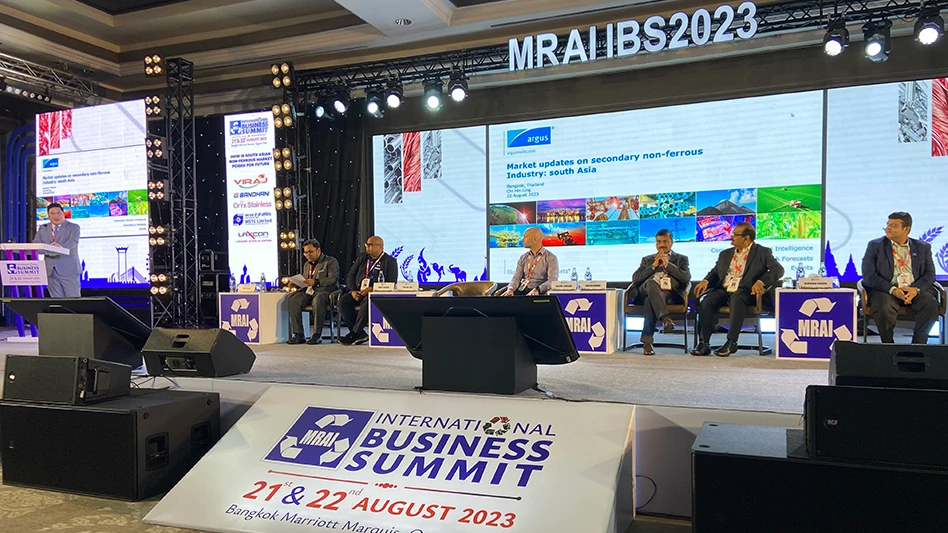
Photo by Recycling Today
Panelists who were part of two nonferrous recycling sessions at the 2023 Material Recycling Association of India (MRAI) International Business Summit in August found several challenges worth mentioning but, overall, optimism was perhaps best summarized by Graeme Cameron of Sims Ltd., who said, “It’s a good time to be in scrap; we see some great opportunities.”
Foremost among the challenges is procuring and processing enough aluminum, copper and other nonferrous scrap to meet surging global demand.
For buyers in scrap-deficit nations such as India, one potential problem arises if secondary metal producers in scrap-surplus nations such as the United States increase their appetite for scrap.
Brad Miller, who oversees the Singapore office for U.S.-based David J. Joseph Co., said, “We see a lot of lower-grade materials that had been shipped to Asia” being processed and consumed domestically, with new secondary aluminum and copper capacity being installed.
“There are significant investments that should come onboard in the next couple of years, especially in aluminum,” Cameron said of the situation in the U.S., adding that that country always has had strong demand for aluminum scrap and nonetheless exported 1.5 million metric tons of the material last year.
Miller said the combination of domestic and overseas demand for U.S. nonferrous scrap could create a premium for U.S. material, especially if outbound scrap flows from Europe are pinched by trade hurdles being erected there.
Cameron said scrap import standards will tighten in part because of those looming hurdles, saying of government scrutiny of inbound material, “We can’t put that back in the bottle.”
Jayant Jain of India-based GR Metalloys said of his own company’s and country’s scrap needs, “Going forward, the requirements will be tremendous.” He did not rule out GR Metalloys setting up trading offices or facilities in scrap surplus nations. “Definitely, we will have to take steps to feed our plants.”
Jane Chen, CEO of Texas-based C & Y Global Inc., said while demand is indeed poised to rise, factors also are pointing to increased scrap supplies emanating from the U.S. She cited gains in domestic manufacturing activity in the U.S., as well as infrastructure spending, including in copper-intensive sectors such as alternative energy and electric vehicles (EVs).
Jawed Ahmed, who works from Dubai for Saudi Arabia-based Al-Qaryan International, described red metal scrap generation as healthy in the Middle East. He also said Chinese metal producers, after using scrap to build their nation the past 30 years, may not need to import as much going forward, leaving material for other parts of Asia.
Mayank Pareek of India-based Jain Recycling Pvt. Ltd. said India’s secondary metals production could benefit from two things: the gravitation of scrap collection and processing away from the “informal sector” and the recalibration of a trade agreement with ASEAN (the Association of Southeast Asian Nations) that has made it, in his estimate, too beneficial to import finished and semifinished metal into India from places such as Malaysia, Thailand and Indonesia.
Also on the demand side, Devendra Surana of India-based Bhagyanagar Copper said in his sector, as with stainless steel, scrap content will play a role in lowering CO2 emissions. “Scrap is the best way to import” low-carbon inputs, he said.
Naveen Sharma of India-based lead producer Gravita said while EV production is making headlines, lead-acid batteries remain a growing sector in most of Asia. He predicted demand for lead to recycle in India will remain firm, and EVs will not replace so fast internal combustion engine vehicles in South Asia and Southeast Asia, compared with China and Western Europe.
The challenges, overall, seem outweighed by the opportunities, several panelists said.
Chi Hin Ling, a commodities reporter for business information services firm Argus, said nonferrous metal scrap imports in India are all rising. Citing lead as one example, Ling said India continues to need lead-acid batteries, but has no virgin resources. "Where are they going to find that? Probably from recycling," Ling said.
He also noted that while London Metal Exchange (LME) nickel prices have dropped about 30 percent year to date, stainless steel scrap prices have moved down by only about 10 percent, showing implicit demand for the material.
Foreseeing a bright future were Cameron and Miller, with Miller saying the “scrap industry is resilient” and that even amidst turmoil scrap finds its way to hungry markets. Cameron, in addition to citing industrywide opportunities, said Australia-based Sims, which has yards there, in the U.S. and the United Kingdom (all outside the EU with its looming regulatory framework), is in “an ideal [position] to navigate around various restrictions.”
The MRAI 2023 International Business Summit was Aug. 21-22 at the Marriott Marquis Queen’s Park in Bangkok.
Latest from Recycling Today
- Unifi launches Repreve with Ciclo technology
- Fenix Parts acquires Assured Auto Parts
- PTR appoints new VP of independent hauler sales
- Updated: Grede to close Alabama foundry
- Leadpoint VP of recycling retires
- Study looks at potential impact of chemical recycling on global plastic pollution
- Foreign Pollution Fee Act addresses unfair trade practices of nonmarket economies
- GFL opens new MRF in Edmonton, Alberta






